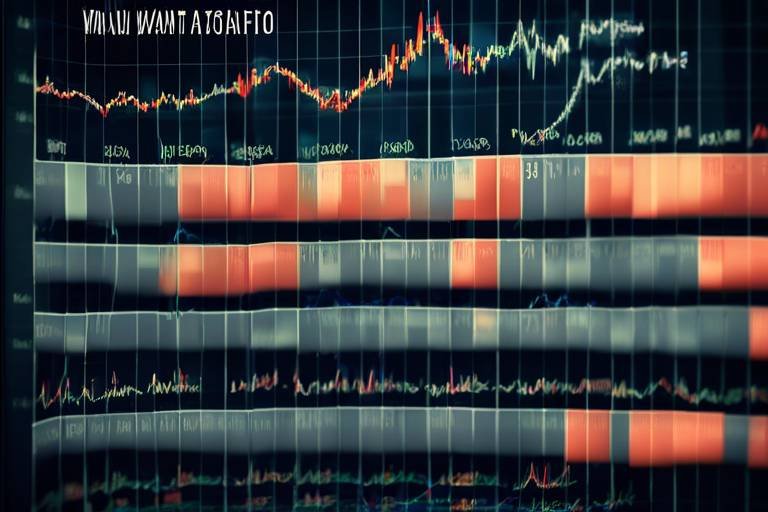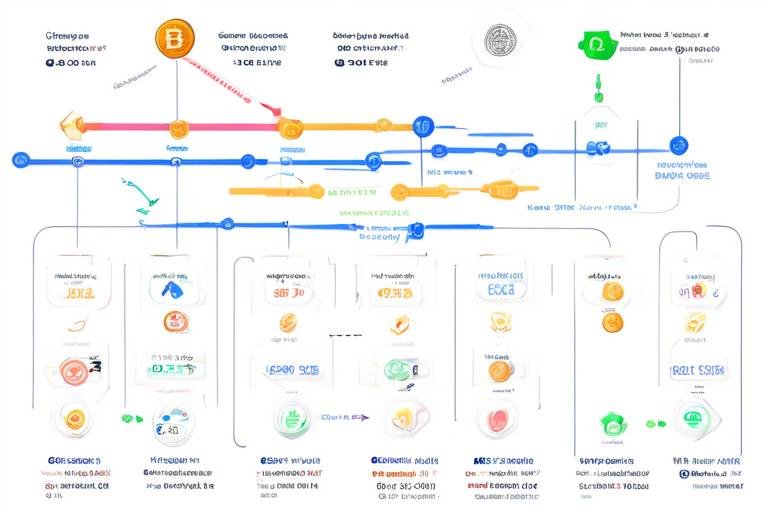How to Use Market Indicators to Enhance Your Strategy
In the fast-paced world of trading, having the right tools at your disposal can be the difference between success and failure. Market indicators serve as your compass, guiding you through the tumultuous waters of the financial markets. But how do you effectively use these indicators to enhance your trading strategy? In this article, we’ll dive deep into the various types of market indicators, their significance, and how you can integrate them into your trading approach to make informed decisions and optimize your investment outcomes.
Market indicators are essential tools that provide insights into market trends and conditions. Think of them as the eyes and ears of your trading strategy, offering a clearer view of what's happening beneath the surface. By understanding these indicators, you can better navigate the complexities of the market. They can be broadly categorized into three types: leading, lagging, and coincident indicators. Each type serves a unique purpose and can significantly impact your trading decisions.
When it comes to market indicators, variety is the spice of life. Let’s break down the different types:
- Leading Indicators: These indicators predict future market movements. They are like the crystal balls of trading, giving you a glimpse into what might happen next.
- Lagging Indicators: As the name suggests, these indicators follow market trends and confirm patterns. They are akin to a rearview mirror, helping you see where you’ve been.
- Coincident Indicators: These indicators move in tandem with the market, providing real-time insights into current conditions.
Leading indicators are your early warning system, alerting you to potential price changes before they happen. Some popular leading indicators include:
- Moving Averages: These smooth out price data to identify trends over specific periods. They help you see the forest for the trees, allowing you to make more informed decisions.
- Sentiment Analysis: This gauges market participants' feelings and expectations, giving you a sense of the market's mood. Are traders feeling bullish or bearish? This insight can be invaluable.
Moving averages come in two main flavors: simple and exponential. The simple moving average (SMA) calculates the average price over a specific time frame, while the exponential moving average (EMA) gives more weight to recent prices, making it more responsive to new information. By incorporating moving averages into your trading strategy, you can identify trends and potential reversal points more effectively.
Sentiment analysis is like reading the room before making your move. By assessing market sentiment, you can gauge whether traders are optimistic or pessimistic about future price movements. Tools like surveys, social media sentiment, and news analysis can help you tap into the collective psyche of the market. This understanding can shape your trading decisions, allowing you to position yourself ahead of the crowd.
While leading indicators offer predictions, lagging indicators confirm trends. They are essential for validating your trading strategy. Common lagging indicators include:
- Relative Strength Index (RSI): This momentum oscillator measures the speed and change of price movements, helping you identify overbought or oversold conditions.
- Moving Average Convergence Divergence (MACD): This indicator shows the relationship between two moving averages of a security's price, providing insights into momentum and trend direction.
Integrating market indicators into your trading strategy can significantly enhance your decision-making process. Here’s how you can effectively incorporate them:
Using multiple indicators in tandem can provide a comprehensive market view. However, be cautious! Overloading your strategy with too many indicators can lead to confusion. Instead, focus on a select few that complement each other. For example, combining a leading indicator like a moving average with a lagging indicator like the RSI can enhance your accuracy and reduce false signals.
Backtesting is the process of evaluating the effectiveness of your trading strategy using historical data. It’s like a dress rehearsal before the big performance. By testing your indicators against past market conditions, you can gain valuable insights into their reliability. This practice not only builds confidence but also helps you refine your strategy for better performance in real-world trading.
1. What are market indicators?
Market indicators are statistical measures that provide insights into market trends and conditions, helping traders make informed decisions.
2. How can I use leading indicators in my trading strategy?
Leading indicators can be used to predict future price movements, allowing you to make proactive trading decisions before trends fully develop.
3. Why is backtesting important?
Backtesting allows traders to evaluate the effectiveness of their strategies using historical data, helping to refine approaches and improve confidence in decision-making.

Understanding Market Indicators
Market indicators are essential tools that provide insights into market trends and conditions. Think of them as your personal weather forecast for trading; just as a meteorologist uses data to predict rain or sunshine, traders use market indicators to forecast price movements and make informed decisions. These indicators can be categorized into several types, each playing a unique role in helping investors navigate the often tumultuous waters of the financial markets.
Understanding market indicators is crucial for anyone looking to enhance their trading strategy. They serve as a compass, guiding you through the complexities of market sentiment, price action, and volatility. By integrating these indicators into your trading plan, you can better anticipate potential market shifts and adjust your strategies accordingly. This proactive approach can significantly improve your investment outcomes.
There are three primary types of market indicators: leading, lagging, and coincident. Each type offers a different perspective on market conditions:
- Leading Indicators: These indicators are designed to predict future price movements. They provide early signals that can help traders make timely decisions.
- Lagging Indicators: These indicators follow market trends and confirm patterns. They are often used to validate the strength of a trend after it has begun.
- Coincident Indicators: These indicators move in tandem with the economy and provide real-time insights into current market conditions.
By understanding these different types of indicators, traders can create a more robust trading strategy. For instance, a trader might use leading indicators to identify potential entry points while relying on lagging indicators to confirm their decisions. This combination can help reduce the chances of false signals and improve overall trading performance.
In summary, market indicators are invaluable for traders seeking to optimize their strategies. They provide a framework for analyzing market behavior, allowing traders to make data-driven decisions rather than relying solely on intuition. As we delve deeper into the types of market indicators in the following sections, you'll gain a clearer understanding of how to leverage these tools effectively in your trading journey.

Types of Market Indicators
When diving into the world of trading, understanding the is crucial for developing a successful strategy. Market indicators can be broadly categorized into three main types: leading indicators, lagging indicators, and coincident indicators. Each of these categories serves a unique purpose in the analysis of market trends and can significantly influence your trading decisions.
Leading indicators are like the crystal balls of the trading world; they attempt to predict future price movements before they happen. Think of them as your early warning system, alerting you to potential changes in the market. For instance, tools like moving averages and sentiment analysis fall under this category. They help traders gauge whether the market is likely to shift direction, enabling them to make informed decisions before the crowd catches on.
On the other hand, lagging indicators are more like the rearview mirror of your trading vehicle. They follow market trends and confirm patterns after they have occurred. Indicators such as the Relative Strength Index (RSI) and Moving Average Convergence Divergence (MACD) are prime examples. These tools can help you validate whether a trend is still in play or if a reversal might be on the horizon.
Lastly, we have coincident indicators, which move in tandem with the market. They provide real-time data that reflects the current state of the market. For example, employment rates and GDP growth are coincident indicators that can give traders insight into the overall health of the economy, influencing their trading strategies accordingly.
To summarize, here's a quick overview of the types of market indicators:
| Type | Description | Examples |
|---|---|---|
| Leading Indicators | Predict future market movements. | Moving Averages, Sentiment Analysis |
| Lagging Indicators | Confirm trends after they occur. | RSI, MACD |
| Coincident Indicators | Move with the market, reflecting current conditions. | Employment Rates, GDP Growth |
Understanding these types of indicators allows traders to better navigate the complexities of the market. Each indicator can provide valuable insights, but the key is knowing when and how to use them effectively in your trading strategy. By mastering these tools, you'll be well-equipped to enhance your market analysis and make more informed trading decisions.
- What are market indicators? Market indicators are statistical tools used to analyze market trends and conditions, helping traders make informed decisions.
- How do I choose the right indicators? Choosing the right indicators depends on your trading strategy and goals. Experiment with different indicators to see which ones align best with your approach.
- Can I rely solely on indicators for trading decisions? While indicators provide valuable insights, they should be used in conjunction with other analysis methods and market research for the best results.

Leading Indicators
Leading indicators are like the crystal balls of the trading world; they give us a glimpse into what might happen in the future. By analyzing these indicators, traders can make more informed decisions, potentially capitalizing on upcoming market movements before they occur. The beauty of leading indicators lies in their ability to forecast trends, providing traders with the foresight needed to navigate the often-turbulent waters of financial markets. Two of the most popular leading indicators are Moving Averages and Sentiment Analysis, each serving a unique purpose in the trader's toolkit.
Moving Averages are particularly effective in smoothing out price data over a specific period, allowing traders to identify trends without the noise of daily price fluctuations. There are two main types of moving averages that traders frequently use: the Simple Moving Average (SMA) and the Exponential Moving Average (EMA). The SMA is calculated by adding the closing prices over a specified number of periods and dividing by that number. In contrast, the EMA gives more weight to recent prices, making it more responsive to new information. This responsiveness can be crucial in fast-moving markets where timing is everything.
To illustrate the effectiveness of moving averages, consider the following table which highlights the differences between SMA and EMA in terms of responsiveness and calculation:
| Indicator | Responsiveness | Calculation Method |
|---|---|---|
| Simple Moving Average (SMA) | Less responsive to recent price changes | Average of closing prices over a set number of periods |
| Exponential Moving Average (EMA) | More responsive to recent price changes | Weighted average that gives more importance to recent prices |
On the other hand, Sentiment Analysis gauges the mood of the market, tapping into the collective psychology of traders. By assessing whether the market is feeling bullish or bearish, traders can align their strategies accordingly. Tools such as social media sentiment analysis, news sentiment tracking, and even surveys can provide valuable insights into market sentiment. For instance, if sentiment analysis reveals that a significant number of traders are optimistic about a particular stock, it might be a signal to buy before the price rises. Conversely, a negative sentiment could indicate a potential downturn, prompting traders to sell or short their positions.
Incorporating leading indicators into your trading strategy can be a game-changer. However, it’s crucial to remember that no indicator is foolproof. They should be used in conjunction with other forms of analysis and risk management strategies. By combining the predictive power of leading indicators with sound trading practices, you can enhance your chances of success in the market.

Moving Averages
Moving averages are like the steady heartbeat of the market, providing traders with a clear view of price trends over time. By smoothing out price fluctuations, they help identify the underlying direction of an asset, making it easier to make informed trading decisions. There are two primary types of moving averages that traders commonly use: Simple Moving Averages (SMA) and Exponential Moving Averages (EMA).
The Simple Moving Average calculates the average price over a specific number of periods, giving equal weight to each price point. For example, a 10-day SMA adds up the closing prices for the last 10 days and divides by 10. This method is straightforward but can be slow to react to sudden price changes. On the other hand, the Exponential Moving Average gives more weight to recent prices, making it more responsive to new information. This can be particularly useful in a volatile market where quick decisions are essential.
Here's a quick comparison of the two:
| Feature | Simple Moving Average (SMA) | Exponential Moving Average (EMA) |
|---|---|---|
| Weighting | Equal weight to all prices | More weight to recent prices |
| Reaction to Price Changes | Slower | Faster |
| Use Case | Long-term trends | Short-term trading |
To effectively incorporate moving averages into your trading strategy, consider the following:
- Identify Trend Direction: Use moving averages to determine if the market is in an uptrend, downtrend, or sideways movement.
- Crossovers: Watch for crossovers between the SMA and EMA, which can signal potential buy or sell opportunities. For instance, when the EMA crosses above the SMA, it may indicate a bullish trend.
- Support and Resistance Levels: Moving averages can also act as dynamic support and resistance levels, helping traders identify potential entry and exit points.
In summary, moving averages are a powerful tool in a trader's arsenal. By understanding how to use both SMA and EMA, you can enhance your market analysis and make more informed decisions. Remember, the key is to use them in conjunction with other indicators to confirm signals and reduce the chances of false positives.
Q: What is the primary use of moving averages in trading?
A: Moving averages are primarily used to identify trends, determine potential support and resistance levels, and generate buy or sell signals through crossovers.
Q: How do I choose the right period for moving averages?
A: The choice of period depends on your trading strategy. Shorter periods (like 10 or 20 days) are better for day trading, while longer periods (like 50 or 200 days) are suited for long-term investing.
Q: Can moving averages be used in any market?
A: Yes, moving averages can be applied to any market, including stocks, forex, and commodities, making them versatile tools for traders.

Sentiment Analysis
Sentiment analysis is a fascinating tool that dives deep into the collective emotions and attitudes of market participants. It’s like having a pulse on the market, allowing traders to gauge whether the mood is bullish or bearish. By understanding market sentiment, you can make more informed trading decisions, much like reading the room before making a big announcement. But how do you tap into this wealth of information?
There are several methods to conduct sentiment analysis, and they can be broadly categorized into quantitative and qualitative approaches. Quantitative sentiment analysis often relies on data from social media platforms, news articles, and other digital sources. By aggregating this data, traders can identify trends that signal potential market movements. For instance, if a majority of tweets about a particular stock are positive, it might indicate a bullish sentiment. On the flip side, a surge in negative mentions could spell trouble.
Qualitative sentiment analysis, on the other hand, involves a more subjective approach. This could include evaluating the tone of news articles or expert opinions regarding a particular market or asset. Think of it as reading between the lines. For example, if financial analysts are expressing concern about an upcoming earnings report, this might indicate a bearish sentiment that could affect stock prices.
To effectively utilize sentiment analysis in your trading strategy, consider the following tools:
- Social Media Monitoring Tools: Platforms like Twitter and StockTwits can provide real-time insights into what traders are feeling.
- News Aggregators: Tools that compile news articles and headlines can help you stay updated on market sentiment.
- Sentiment Indices: Some financial websites offer sentiment indices that quantify market sentiment, making it easier to interpret data.
By integrating sentiment analysis into your trading strategy, you can enhance your ability to predict market movements. Just remember, while sentiment can provide valuable insights, it should not be the sole basis for your trading decisions. Instead, think of it as an additional layer of context that complements other market indicators.
- What is sentiment analysis? Sentiment analysis is a method used to gauge the emotions and attitudes of market participants, helping traders understand market mood.
- How can I conduct sentiment analysis? You can conduct sentiment analysis using social media monitoring tools, news aggregators, and sentiment indices.
- Is sentiment analysis reliable? While sentiment analysis can provide valuable insights, it should be used in conjunction with other indicators for a more comprehensive market view.

Lagging Indicators
Lagging indicators are like the rearview mirror of the trading world; they help you confirm trends that have already taken shape. While they might not predict future movements, they provide valuable insights into the strength and sustainability of a trend, making them vital for any trader looking to make informed decisions. Imagine driving a car: you wouldn’t solely rely on the rearview mirror, but it certainly helps you understand where you've been and whether the path is clear ahead.
Two of the most commonly used lagging indicators are the Relative Strength Index (RSI) and the Moving Average Convergence Divergence (MACD). Both of these indicators are designed to help traders identify potential entry and exit points by confirming the momentum of price movements.
The Relative Strength Index (RSI) is a momentum oscillator that measures the speed and change of price movements. It ranges from 0 to 100 and is typically used to identify overbought or oversold conditions in a market. An RSI above 70 often indicates that an asset is overbought, while an RSI below 30 suggests it might be oversold. This can serve as a signal for traders to reconsider their positions. For example, if the RSI is showing an overbought condition while the price continues to rise, it could be a warning sign that a reversal may be imminent.
On the other hand, the Moving Average Convergence Divergence (MACD) is a trend-following momentum indicator that shows the relationship between two moving averages of a security’s price. The MACD is calculated by subtracting the 26-period exponential moving average (EMA) from the 12-period EMA. The result of this calculation is the MACD line. Traders often look for crossovers between the MACD line and the signal line (the 9-period EMA of the MACD) to identify potential buy or sell signals. A bullish crossover occurs when the MACD line crosses above the signal line, while a bearish crossover happens when it crosses below.
| Indicator | Purpose | Key Levels |
|---|---|---|
| Relative Strength Index (RSI) | Identify overbought or oversold conditions | Above 70 (overbought), Below 30 (oversold) |
| Moving Average Convergence Divergence (MACD) | Signal potential buy or sell opportunities | Crossovers of MACD line and signal line |
Incorporating lagging indicators into your trading strategy can help you avoid false signals and make more informed decisions. However, it’s crucial to remember that while these indicators can confirm trends, they do not predict them. Therefore, using them in conjunction with leading indicators can provide a more comprehensive view of market conditions. Think of it as having both a map and a compass; while the map shows you where you are and where you’ve been, the compass helps you navigate toward your destination.
Ultimately, understanding how to effectively utilize lagging indicators like the RSI and MACD can enhance your trading strategy, allowing you to make more confident decisions based on confirmed market trends. Just like any tool in your trading toolbox, the key is knowing when and how to use these indicators to your advantage.

Using Indicators in Your Strategy
Incorporating market indicators into your trading strategy can significantly enhance your decision-making process. Think of market indicators as your personal GPS in the vast world of trading; they help you navigate through the uncertainties and complexities of the market landscape. Just like a GPS provides you with real-time traffic updates, market indicators give you insights into market trends and potential price movements. But how do you effectively integrate these indicators into your strategy?
First and foremost, it's crucial to understand that not all indicators are created equal. Each indicator has its unique strengths and weaknesses, so it's essential to choose the right ones that align with your trading goals. For instance, while some traders may prefer leading indicators to anticipate future movements, others might rely on lagging indicators to confirm trends. The key is to find a balance that works for you.
One effective way to integrate indicators into your strategy is by combining different types. Using multiple indicators can provide a more comprehensive view of the market. For example, you might pair a leading indicator, such as a moving average, with a lagging indicator like the Relative Strength Index (RSI). This combination allows you to identify potential entry and exit points while also confirming the strength of a trend. However, be cautious not to overload your strategy with too many indicators, as this can lead to confusion and conflicting signals.
Another vital aspect of using indicators is backtesting your strategy. Backtesting involves evaluating your trading strategy using historical data to see how it would have performed in the past. This process not only helps you refine your strategy but also builds your confidence in the indicators you choose to use. When backtesting, consider the following:
| Step | Description |
|---|---|
| 1 | Select your indicators and time frames. |
| 2 | Gather historical price data for analysis. |
| 3 | Run simulations to see how your strategy performs. |
| 4 | Analyze the results and adjust your strategy as needed. |
By following these steps, you can effectively test the viability of your market indicators and ensure that your strategy is robust. Remember, the goal is not just to find indicators that work but to create a cohesive strategy that leverages their strengths.
As you develop your trading strategy, always keep in mind the importance of staying adaptable. Market conditions can change rapidly, and what works today may not work tomorrow. Regularly review your indicators and be open to adjusting your strategy based on new market insights. This flexibility will help you stay ahead of the curve and optimize your investment outcomes.
In conclusion, using market indicators in your trading strategy is not just about following the numbers; it's about understanding the story they tell. By combining indicators, backtesting your strategies, and remaining adaptable, you can enhance your trading decisions and navigate the market with confidence.
- What are market indicators? Market indicators are tools that help traders analyze market trends and make informed decisions based on price movements.
- How do I choose the right indicators for my strategy? Choose indicators that align with your trading goals and style. Consider both leading and lagging indicators for a balanced approach.
- What is backtesting, and why is it important? Backtesting is the process of testing a trading strategy using historical data to evaluate its effectiveness. It helps traders refine their strategies and build confidence.
- Can I use multiple indicators at once? Yes, using multiple indicators can provide a more comprehensive view of the market. Just be careful not to overload your strategy with too many indicators.

Combining Indicators
When it comes to trading, relying on a single market indicator can be like trying to navigate a dense forest with only a compass. Sure, it gives you a direction, but without additional tools, you might miss crucial details along the way. This is where comes into play. By using multiple indicators together, you create a more comprehensive view of the market, which can significantly enhance your trading decisions.
Think of it this way: just as a chef uses various ingredients to create a delicious dish, traders can mix different indicators to refine their strategies. For instance, using a leading indicator like the Moving Average alongside a lagging indicator such as the Relative Strength Index (RSI) can provide a clearer picture of potential price movements. The moving average helps identify the overall trend, while the RSI can indicate whether the market is overbought or oversold, allowing for more informed entry and exit points.
However, not all combinations are created equal. It's essential to choose indicators that complement each other rather than overlap in what they measure. For example, using two momentum indicators might lead to redundant signals, while mixing a momentum indicator with a trend indicator can enhance your strategy. Here’s a quick look at some effective combinations:
| Indicator Type | Indicator Name | Purpose |
|---|---|---|
| Leading | Moving Average | Identifies the trend direction |
| Lagging | Relative Strength Index (RSI) | Indicates overbought or oversold conditions |
| Leading | Bollinger Bands | Measures market volatility and price levels |
| Lagging | MACD (Moving Average Convergence Divergence) | Confirms trends and potential reversals |
To effectively combine indicators, consider the following best practices:
- Understand Each Indicator: Before combining, ensure you fully grasp how each indicator works and what signals it provides.
- Avoid Redundancy: Choose indicators that provide different types of information to avoid receiving the same signals.
- Test Your Combinations: Use historical data to backtest your combinations and see how they would have performed in various market conditions.
By thoughtfully combining indicators, you not only enhance your analytical capabilities but also reduce the risk of making decisions based on misleading signals. Remember, the goal is to create a robust trading strategy that adapts to market changes and provides you with the confidence to make informed trades.
Q: How many indicators should I use together?
A: It's generally best to use 2-4 indicators to avoid cluttering your analysis. Focus on those that complement each other.
Q: Can I use the same type of indicators?
A: While you can use the same type, it's usually more effective to mix different types (e.g., one leading and one lagging) to get a well-rounded view.
Q: How do I know if my combinations are working?
A: Backtesting your strategy with historical data can help you evaluate the effectiveness of your indicator combinations.

Backtesting Your Strategy
Backtesting is an essential part of developing a successful trading strategy. It allows traders to evaluate how their strategies would have performed in the past using historical data. Think of it as a time machine that takes you back to see how your trading decisions would have panned out. By examining past market conditions, you can gain invaluable insights into the effectiveness of your indicators and overall trading plan.
To effectively backtest your strategy, you need to follow a systematic approach. First, gather historical data relevant to the assets you plan to trade. This data can include price movements, volume, and any other indicators you intend to use. Next, define your trading rules clearly—what indicators trigger a buy or sell signal? This is crucial, as ambiguous rules can lead to inconsistent results.
Once you have your data and rules in place, run your backtest using a trading simulator or software that supports backtesting. This software can help you visualize your trades and see how they would have performed over time. As you analyze the results, pay close attention to key performance metrics such as:
| Metric | Description |
|---|---|
| Win Rate | The percentage of trades that were profitable. |
| Average Gain/Loss | The average amount gained or lost per trade. |
| Maximum Drawdown | The largest drop from a peak to a trough in your account balance. |
| Return on Investment (ROI) | The percentage return on your total investment over the backtesting period. |
These metrics will help you gauge the viability of your strategy. However, backtesting isn't just about the numbers; it's also about understanding market conditions. For instance, a strategy that performs well in a trending market may not be as effective in a sideways market. This is where the concept of market regimes comes into play. By recognizing different market conditions, you can adjust your strategy accordingly.
Another critical aspect to consider is the overfitting trap. This happens when your strategy is too finely tuned to past data, making it less effective in real-time trading. To avoid this, ensure your strategy remains flexible and adaptable. A good practice is to reserve a portion of your data for out-of-sample testing, which helps validate the robustness of your strategy.
Finally, once you've completed your backtesting, document your findings. Keeping a trading journal can be incredibly beneficial. It allows you to track your thoughts, emotions, and decisions, helping you refine your strategy over time. Remember, the goal of backtesting is not just to find a strategy that worked in the past but to develop a framework that can help you navigate the unpredictable waters of the financial markets.
- What is backtesting? Backtesting is the process of testing a trading strategy using historical data to see how it would have performed.
- Why is backtesting important? It helps traders evaluate the effectiveness of their strategies and make informed adjustments before risking real capital.
- How can I avoid overfitting? Keep your strategy flexible, use out-of-sample testing, and avoid making overly complex rules based solely on past performance.
- What metrics should I focus on during backtesting? Key metrics include win rate, average gain/loss, maximum drawdown, and return on investment (ROI).
Frequently Asked Questions
- What are market indicators?
Market indicators are statistical tools that help traders analyze market trends and conditions. They provide insights that can guide trading decisions, making it easier to identify potential price movements and optimize investment strategies.
- What is the difference between leading and lagging indicators?
Leading indicators are designed to predict future price movements, giving traders potential signals before changes occur. In contrast, lagging indicators confirm trends after they have happened, helping traders understand the strength of an existing trend.
- How do I use moving averages in my trading strategy?
Moving averages help smooth out price data over a specific period, making it easier to identify trends. You can use simple moving averages (SMA) to gauge overall trends or exponential moving averages (EMA) for a more responsive indicator that reacts quickly to price changes.
- What is sentiment analysis and how can it help me?
Sentiment analysis involves gauging the feelings and expectations of market participants. By understanding market sentiment, you can make more informed decisions, as it can indicate whether the market is bullish or bearish, potentially influencing price movements.
- Can I combine different indicators in my strategy?
Absolutely! Combining multiple indicators can provide a more comprehensive view of the market. For example, using a leading indicator with a lagging one can help confirm signals, reducing the chances of false positives and improving decision-making.
- What is backtesting and why is it important?
Backtesting is the process of testing your trading strategy against historical data to evaluate its effectiveness. It allows you to see how your strategy would have performed in the past, helping you refine your approach and increase your chances of success in the future.
- How can I start using market indicators effectively?
To start using market indicators effectively, begin by familiarizing yourself with different types of indicators. Choose a few that align with your trading style, and practice integrating them into your strategy. Don't forget to backtest your approach to ensure it works before trading with real money!



















